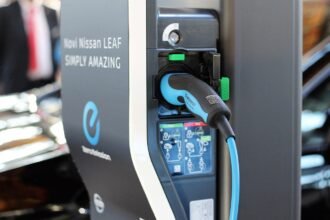Lidar in Self-Driving Cars: Have you ever wondered how self-driving cars navigate complex roads, identify obstacles, or even make split-second decisions? What makes them so “intelligent” that they can drive without human intervention? The secret lies in advanced sensor technologies, and one of the most critical among them is Lidar. But how does Lidar actually work, and why is it so essential to the future of self-driving cars in the USA?
In this comprehensive article, we’ll take a deep dive into the world of Lidar technology, explaining what it is, how it works, and why it plays a pivotal role in autonomous driving. We’ll also look at how this technology is shaping the future of transportation, especially in the USA, where the self-driving car industry is growing rapidly.
What is Lidar in Self-Driving Cars?
Lidar (Light Detection and Ranging) is a remote sensing method that uses light in the form of pulsed laser beams to measure distances between the sensor and objects in the environment. In simple terms, it’s like giving the car a pair of highly sensitive “eyes” that can detect objects, their size, shape, and how far away they are. Unlike traditional cameras, Lidar works effectively in different lighting conditions, making it an invaluable tool for self-driving cars.
How Does Lidar Work?
Lidar in Self-Driving Cars work by emitting millions of laser pulses per second. These pulses bounce off surrounding objects, and the system measures the time it takes for the light to return. Using these measurements, Lidar creates a highly detailed 3D map of the car’s environment, identifying obstacles, pedestrians, and other vehicles in real-time.
Why is Lidar Essential for Self-Driving Cars?

Lidar in Self-Driving Cars is one of the most crucial technologies enabling safe and efficient self-driving cars. Here’s why:
- High Precision and Accuracy: Lidar provides precise 3D mapping of the environment, detecting even small obstacles with high accuracy.
- Works in All Lighting Conditions: Unlike cameras, which can struggle in low-light or extremely bright conditions, Lidar works just as well day or night.
- Real-Time Data Processing: Lidar provides real-time data, allowing self-driving cars to make instantaneous decisions, ensuring the vehicle can react to sudden changes in the environment.
- Redundancy for Enhanced Safety: In self-driving systems, multiple sensors are used to ensure safety. Lidar adds an extra layer of redundancy by working alongside cameras and radar to confirm the presence of obstacles.
- Depth Perception: Cameras provide visual data, but Lidar excels in depth perception, giving self-driving cars a better understanding of their surroundings.
Comparison of Lidar with Other Self-Driving Sensors
| Sensor Type | Key Strengths | Limitations | Common Usage |
|---|---|---|---|
| Lidar | High accuracy in detecting obstacles, depth perception, works in all lighting conditions | High cost, sensitive to weather conditions like rain and fog | Mapping, obstacle detection |
| Cameras | Visual recognition of signs, traffic lights, and lanes | Limited in poor lighting or glare | Visual navigation, object classification |
| Radar | Long-range detection, works well in all weather conditions | Lacks detailed resolution | Object detection at high speeds |
| Ultrasonic Sensors | Low-cost, useful for short-range detection | Limited range, only effective at close distances | Parking assistance, low-speed obstacle detection |
How Lidar Integrates with Other Self-Driving Sensors
Self-driving cars rely on a combination of sensors to operate safely and efficiently. Lidar is usually combined with radar, cameras, and ultrasonic sensors to create a robust sensor fusion system. Each sensor plays a distinct role:
- Cameras help with recognizing traffic signs, lane markings, and visual objects.
- Radar provides long-range detection of objects, even in poor weather.
- Ultrasonic sensors are typically used for short-range detection, like during parking.
Lidar complements these technologies by providing detailed, real-time 3D maps of the car’s environment, making it the backbone of many self-driving systems in the USA.
Evolution of Lidar in Self-Driving Cars
The use of Lidar in autonomous vehicles has advanced significantly over the past decade. Earlier models were bulky and expensive, costing tens of thousands of dollars. However, recent innovations have led to smaller, more affordable, and more efficient Lidar systems.
- First-Generation Lidar: Expensive and large, often mounted on the roof of early self-driving cars.
- Second-Generation Lidar: Smaller, more cost-effective, but still relatively high-priced.
- Current Generation: Compact Lidar systems that can be integrated seamlessly into the body of the vehicle, reducing cost while improving performance.
As of 2024, many companies in the USA, such as Waymo, Tesla (although Tesla primarily focuses on camera-based systems), and Ford, are either using or researching Lidar as a primary sensor in their self-driving vehicles.
Benefits of Lidar in Self-Driving Cars
some of the Benefits of Lidar in Self-Driving Cars
- Improved Safety: Lidar’s ability to detect obstacles in real-time ensures safer navigation, particularly in complex driving environments like city traffic.
- Enhanced Precision: The 3D maps generated by Lidar offer a more detailed representation of the environment than what radar or cameras alone can provide.
- Adaptability: Lidar works across various lighting conditions, making it ideal for nighttime driving, tunnels, and other low-visibility scenarios.
- Dynamic Decision Making: The combination of real-time data and high-resolution mapping enables self-driving cars to make quick, informed decisions, even in unpredictable conditions.
FAQs on Lidar in Self-Driving Cars
Q1: Why is Lidar better than cameras in self-driving cars?
A: Lidar provides superior depth perception and is not affected by lighting conditions. While cameras can identify objects visually, Lidar can determine the distance between the vehicle and the object more accurately.
Q2: How expensive is Lidar technology?
A: While Lidar was once extremely expensive, prices have dropped significantly in recent years. Modern Lidar systems are much more affordable, especially with advancements in solid-state Lidar technology.
Q3: Can self-driving cars function without Lidar?
A: Some companies, like Tesla, rely heavily on camera-based systems and have opted not to use Lidar. However, many experts believe that Lidar adds an important layer of safety and accuracy that complements other sensors.
Q4: Is Lidar safe for human eyes?
A: Yes, the lasers used in Lidar operate at safe wavelengths and pose no risk to human eyes or skin.
Q5: How does weather affect Lidar performance?
A: Lidar can be impacted by adverse weather conditions like heavy rain, snow, or fog. However, modern systems are improving in this regard, with better performance in challenging environments.
Future of Lidar in the USA’s Self-Driving Industry
Lidar technology is expected to become more prevalent in the USA’s self-driving car industry over the next decade. As costs continue to drop and performance improves, more automakers will likely integrate Lidar into their self-driving systems. The role of Lidar will also expand beyond cars, potentially being used in drones, robotics, and smart city infrastructure.
Key Trends to Watch
- Affordable Lidar Systems: Companies are working towards making Lidar cost-effective, allowing more manufacturers to adopt the technology.
- Solid-State Lidar: This new generation of Lidar is smaller, more robust, and easier to integrate into vehicles.
- Integration with AI: Lidar data, combined with artificial intelligence, will enhance the decision-making capabilities of autonomous vehicles.
Conclusion: Lidar in Self-Driving Cars
As self-driving cars become more common, Lidar will play an indispensable role in ensuring their safety and efficiency. Its ability to provide real-time, accurate 3D mapping of the environment makes it a superior technology for navigating complex driving situations. Whether it’s city streets, highways, or parking lots, Lidar helps self-driving cars understand their surroundings in a way that no other sensor can. For the self-driving sensors USA needs to thrive, Lidar is essential to overcoming the challenges of autonomous navigation.
In the coming years, as Lidar technology continues to evolve, we can expect it to become even more integral to the future of self-driving vehicles in the USA.








